Agriculture in Puerto Rico
| Part of a series on the |
| Economy of Puerto Rico |
|---|
| Government |
The agriculture industry in Puerto Rico constitutes over $800 million or about 0.62% of the island's gross domestic product (GDP) in 2020 .[1][2][3] Currently the sector accounts for 15% of the food consumed locally.[4] Experts from the University of Puerto Rico argued that these crops could cover approximately 30% of the local demand, particularly that of smaller vegetables such as tomatoes, lettuce, etc. and several kinds of tubers that are currently being imported. The existence of a thriving agricultural economy has been prevented due to a shift in priorities towards industrialization, bureaucratization, mismanagement of terrains, lack of alternative methods and a deficient workforce. Its geographical location within the Caribbean exacerbates these issues, making the scarce existing crops propense to the devastating effects of Atlantic hurricanes.
History[]

Agriculture or farming is concerned with the cultivation of plants, animals and other food sources that sustain life. It also involves growing crops for other purposes. Coffee production, and sugar cane production in Puerto Rico has had a history of ups and downs, affected by hurricanes and by its isolated location, and its political status as a colony of Spain and of the United States.
In 1900, the most important agricultural products in Puerto Rico were "cotton, rice, cacao, corn, coconuts, pepper, bananas, tobacco, vegetable dyes, coffee, sugar, pineapples and vanilla".[5]

Disaster struck in August 1899, when two hurricanes ravaged the island: the 1899 San Ciriaco hurricane on August 8, and an unnamed hurricane on August 22. Approximately 3,400 people died in the floods and thousands were left without shelter, food, or work.[6] The effects on the economy were devastating: millions of dollars were lost due to the destruction of the majority of the sugar and coffee plantations. Afterwards, nearly 5‚000 Puerto Ricans migrated to Hawaii by 1910 to work in the sugar plantations of Hawaii.
In the 1940s and 1950s agriculture continued to play a crucial role in the island's economy with 45% of the labor force employed within the sector in 1940.[7] The cultivation of pineapples was significant until the 1990s when the main buyer Lotus juice company closed.[8]
In 2012, there were 13,159 farms in Puerto Rico.[9] While not a state, Puerto Rico is a member of the Southern United States Trade Association, a non-profit organization that assists the agriculture industry in developing its exports.[10] In early 2020, farm owners in Ponce reported on the continuing challenge of finding laborers.[11]
New farms[]
Because of the 2009 economic crisis and the susceptibility of Puerto Rico to hurricanes, there's been an urgency to push for more farms on the island. While not large enough to produce on a mass scale, the quality of products is high. Farming has a more positive image among young people in Puerto Rico,[12][13][14] however, in places like Ponce, where the weather tends to be hotter, farm owners complain that the turnover rate is too high.[11]
In September 2019, an initiative to diminish the amount of coffee that is imported to Puerto Rico was announced by the Hispanic Federation, leading 1,500 Puerto Rico coffee growers.[15]
Gallery[]
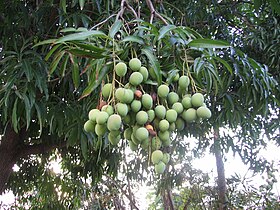
Mango tree in Rincón

In 1941 sugar cane production surged in Río Piedras, now a district of San Juan
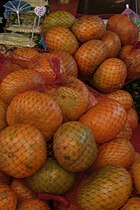
Oranges at festival in Maricao
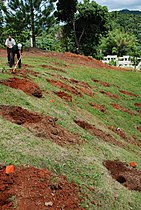
Preparing to plant in Maricao

Students plant a tree at a school in Maricao
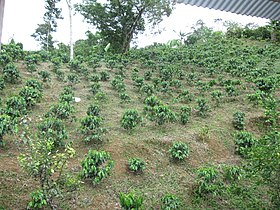
Newly planted coffee trees at Hacienda Lealtad in Lares after Hurricane Maria in 2017 destroyed all its coffee trees
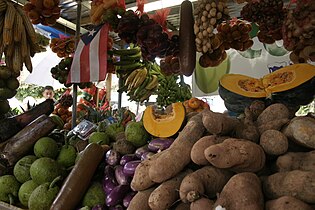
Vegetable and fruit stand at Fiesta Acabe del Café in Maricao in 2014
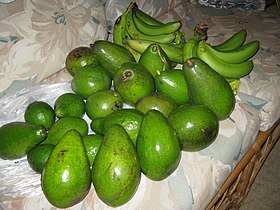
Avocado harvest in Cayey

Coffee near Mayagüez in 1899
See also[]
References[]
- ^ http://www.gdb-pur.com/economy/documents/PREconomicFactSheet2013-Dec.pdf[bare URL PDF]
- ^ "Puerto Rico - GDP distribution across economic sectors 2020". Statista. Retrieved 2022-03-18.
- ^ Ramos Segarra, Christian (2021-04-26). "Con alto potencial la industria del cáñamo" [Hemp industry has high potential]. El Vocero. Retrieved 2022-03-18.
{{cite web}}: CS1 maint: url-status (link) - ^ Salamány, Tatiana Díaz RamosyAdriana De Jesús (2020-05-21). "Múltiples los retos de la agricultura para alimentar en tiempos de crisis" [Multiple challenges of the agriculture sector to feed (the people) in times of crisis]. Centro de Periodismo Investigativo (in Spanish). Retrieved 2022-03-18.
{{cite web}}: CS1 maint: url-status (link) - ^ Herrmann, Karl Stephen (1900). From Yauco to Las Marias: Being a Story of the Recent Campaign in Western Puerto Rico by the Independent Regular Brigade, Under Command of Brigadier-General Schwan. R. G. Badger & Company. p. 95. Retrieved 12 October 2019.
- ^ "Hurricane San Ciriaco". Library of Congress. Retrieved March 26, 2006.
- ^ Ayala, Israel Meléndez; Kennedy, Alicia; Winter, Damon (2021-10-04). "Así es como Estados Unidos controla lo que se come en Puerto Rico" [This is how the United States controls what is eaten in Puerto Rico]. The New York Times (in Spanish). ISSN 0362-4331. Retrieved 2022-03-17.
- ^ VOCERO, Fernando Pereira, Especial para EL (2019-03-19). "Piña manatieña busca ser protagonista" [Manatí Pineapple looks to be protagonist]. El Vocero (in Spanish). Archived from the original on 2021-06-24. Retrieved 2021-06-18.
- ^ "2012 Census of Agriculture Highlights" (PDF). USDA. USDA. Retrieved 27 August 2019.
- ^ "Puerto Rico Department of Agriculture". www.susta.org.
- ^ a b "Persiste la escasez de mano de obra en el suroeste" [Labor shortage persists in the southwest]. El Nuevo Dia. 2020-02-01. Archived from the original on 2020-02-01. Retrieved 2020-02-01.
- ^ "'The push we needed': Puerto Rico's local farmers step up efforts after Hurricane Maria". NBC News.
- ^ Graf, Carly. "Meet the Farmers Reclaiming Puerto Rico's Agricultural History" – via www.yesmagazine.org.
{{cite journal}}: Cite journal requires|journal=(help) - ^ "How Puerto Rico Lost Its Home-Grown Food, But Might Find It Again". NPR. Archived from the original on 2017-03-13.
- ^ "Hispanic Federation lidera potente alianza por el café" [Hispanic Federation leads strong coffee alliance]. El Nuevo Dia. 2019-09-13. Archived from the original on 2022-01-11.
Further reading[]
- Report of the Puerto Rico Agricultural Experiment Station. U.S. Government Printing Office. 1914. Retrieved 12 October 2019.
External links[]
- Agriculture in Puerto Rico
- Economy of Puerto Rico








